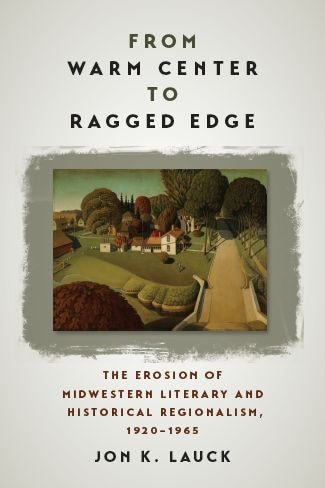Jon K. Lauck's “From the Warm Center to the Ragged Edge” surveys “the erosion of Midwestern literary and historical regionalism” between 1920 and 1965. This may sound boring to those who believe that the “trap” states are largely populated by clodopers, fundamentalist zealots, and loud-mouthed Babbitts. In fact, the Lauck's goal is to examine “how the Midwest as a region faded from our collective imagination” and “became an object of derision.” In particular, the traditional values of hard work, personal dignity and loyalty of the heart, the centrality it places on family, the community and the church, even the Jeffersonian ideal of a democracy based on farms and small holdings of land—all of which came to be regarded as unbearably provincial by East Coast metropolitan slickers and West Coast lotus eaters.
Lauck traces the birth of this condescension to the 1920s, when writers and critics began to attack life in the Midwest as narrow-minded and repressive. Books like Edgar Lee Masters'Spoon River Anthology“Sherwood Anderson”Winesburg, Ohio“and Sinclair Lewis”Central RoadHe quickly portrayed what he called “the revolt from the village.” Town jesters like HL Mencken and magazines like the New Yorker further ridiculed the Midwest as a backward, second-rate culture of yokels and rednecks with no commitment to the intellect. , let alone sensitivity to the arts.
Some critics, such as Bernard DeVoto, have supported these simplistic orthodoxies. As the Nebraska writer Bess Streeter Aldrich poignantly stated, “A writer can depict some of the decent things of life around him and retain the privilege of calling that real life, too.” Many writers, as well as artists such as Thomas Hart Benton and Grant Wood, found “help and support in the social institutions of the rural and small-town Midwest.” In general, Midwesterners tended to reject what North Dakota historian James Mullin called “the literature of satire, mockery, and slander” and championed “the typical American, the common man, and his institutions.”
Early on, advocates of regionalism recognized two powerful enemies: the mass media and federalism. The first led to a mild homogenization of culture and what Josiah Royce called “a monotonously uniform banality of mind.” The latter, beginning with Franklin Roosevelt's New Deal, reduced the ability of localities to govern themselves. After World War II, international fears of communism and nuclear war further strengthened Washington's power as federal institutions increasingly took control of American political life.
Lauck's final chapter examines how historians have studied the heart. Initially, many academics at regional universities were born in the Midwest and saw themselves as inheritors of its values, but over time increased professionalization led younger educators to emphasize academic success among their peers rather than commitment to spiritual well-being of their communities. In this section, Lauck carefully examines the opposing ideas of Richard Hofstadter, author of “The Anti-Intellectual in American Lifeand Russell Kirk of Michigan, author of “The Conservative mindIt also implicitly supports the view—of historians Frederick Jackson Turner and Christopher Lasch—that smaller communities and neighborhoods, not large cities, foster a strong engagement with politics. As Lasch noted, debate is at the foundation of urban life. Not surprisingly, Lauck's own previous book, “The lost area
called for a Midwestern-oriented revival of history.
“From Warm Center to Ragged Edge” is scholarly—there are as many pages of notes as text—and Lauck favors long sentences, which may take some getting used to. But this is an important book, and these days, especially, it is worth reading and discussing.
The same could be said for publications from Belt Publishing. While “How to speak Midwesternby Edward McClelland, is primarily an entertaining glossary of the language of the region's most industrialized states, by Mark AthitakisThe New Midwest: A Guide to Contemporary Fiction of the Great Lakes, Great Plains, and Rust Belt“It's more serious. It rightly praises the Midwestern novels of Marilynne Robinson, Jeffrey Eugenides, Toni Morrison, and Jonathan Franzen, but it also points to works of similar value that warrant rediscovery. These include science fiction.”On Wings of Song“, by Thomas M. Disch; William McPherson's elegant portrait of a Michigan boyhood;Current test“; Nancy Willard's”Things invisible to see
,” which features “an Ann Arbor man pitting his baseball team on earth against one led by Death” andDivine Days
,” Leon Forrest's magnificent attempt to write not just the great African American novel, but the period of the Great American Novel.
To these books about the Midwest, let me close by adding a related one about the South: “Land: The Case for an Agricultural Economy” written in the 1930s by distinguished poet and critic John Crowe Ransom and only recently rediscovered and edited by Jason Peters for Notre Dame Press. In this Ransom joins Lauck in defending the values cultivated by rural and small town America Is that just Maybe, and yet sometimes don't we have to take a step back before we can leap forward?
Michael Dirdareviews books on Thursdays for Style.
FROM WARM CENTER TO HAIRY EDGE
The Erosion of Midwestern Literary and Historical Regionalism, 1920-1965
Pan. of Iowa. 252 pp. Paperback, $27.50

